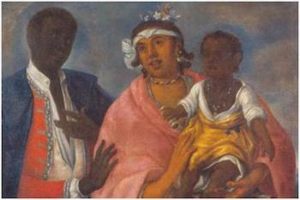
*Zambo (the word) is affirmed on this date in 1500. Zambo is a racial term historically used in the colonies of the Americas.
It is a Spanish and Portuguese expression referring to people of mixed Indigenous and African ancestry. Occasionally in the 21st century, the term is used in the Americas to refer to persons of mixed Black and Indigenous American ancestry. (The analogous English term, sambo, is a slur.) Historically, the racial cross between enslaved Africans and Amerindians was a zambayga, Zambo, and sambo. The meaning of the term sambo, however, is challenged in North America.
The word originated from one of the Romance languages of Latin and its direct descendants. The feminine word is Zambia. Zambo connects to the children of one African and one Amerindian parent or two Zambo parents. In New Spain (colonial Mexico), the term for those of mixed African and indigenous ancestry was Lobo ("wolf"). This term of classification appears in official marriage registers and other official documentation. During the slave period, many other terms denoted individuals of African Amerindian ancestry in ratios smaller or greater than the 50:50 of zambos: cambujo (Zambo-Amerindian mixture).
Today in parts of Spanish America, Zambo refers to all people with significant or visible amounts of both African and Amerindian ancestry. The term Zambo was not formally used in Spanish territories. Competing terms, such as mulatto, were also used. From the beginning of the early sixteenth century, when African slaves were imported to Hispaniola, unions between them, indigenous peoples, and Spanish colonists began to occur. The two non-European groups sometimes worked together in the mines or on the plantations of Hispaniola and other Spanish Caribbean islands following sugar cane production in the 1520s.
In other cases, Africans took refuge in indigenous communities after escaping slavery. Zambos refers to persons who did not have European ancestry, but all sorts of unions took place through the centuries. In the eighteenth century, the Spanish began making formal racial classifications and defined Zambo in what became its final, official meaning. Some Zambo groups became well known after being created by runaway or rebel Africans who mixed with indigenous communities. For example, in what would become Ecuador, a small group of shipwrecked former slaves gained control of some indigenous communities, eventually representing them before the Spanish in the late sixteenth and early seventeenth centuries.
The Mosquito Zambos developed as the descendants of African slaves who revolted in 1640 on a slave ship. They wrecked it at Cape Gracias a Dios on the border between Honduras and Nicaragua to escape into the interior. There they united with the indigenous Miskito people. Afro Miskito people came to dominate the kingdom in the early eighteenth century. They led warriors on slave raids to capture slaves for sale to Europeans. Their alliance and protection of English-speaking merchants and settlers in the area helped Great Britain find the colony of British Honduras (present-day Belize).
Statistically, zambos represent a sizeable number of nonwhites in Colombia, Brazil, Venezuela, Guyana, Ecuador, and Panama. A small but noticeable number of Zambos, resulting from recent unions of Amerindian men to Afro Ecuadorian women, are found in coastal cities of Ecuador. Before the rural-to-urban migration in Ecuador, the Amerindian and Afro Ecuadorian ethnicities were mostly in the Andes region. In Central America, two indigenous-African mixed groups have developed: the Miskito and the Garifuna. The Garifuna originated from the combination of shipwrecked Africans or fled from neighboring islands to St. Vincent during the seventeenth and eighteenth centuries.
In Mexico, they form a sizeable minority. According to the 2015 census Estimate, 896,829 people identified as both Afro Mexican and Indigenous Mexican. The great majority of the country's Afro-descended population has been absorbed into the wider mestizo population. Greater concentrations can be found only in communities scattered around the southern coastal states where many of the country's Afro Mexicans live.
Culturally, Mexican Lobos followed Amerindian traditions rather than African influences, as they often had Amerindian mothers and were brought up in her culture. Such acculturation also took place in Bolivia, where the Afro Bolivian community absorbed and retained many aspects of Amerindian cultural influences, such as dress and the use of the Aymara language. These communities of Afro-Bolivians reside in the Yungas region of the Bolivian department of La Paz.